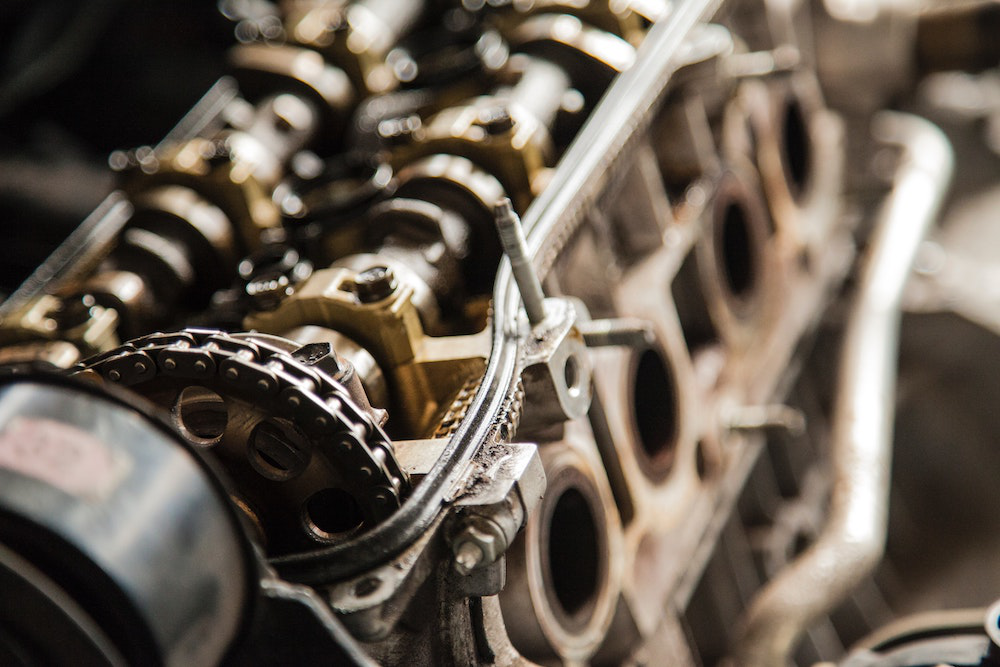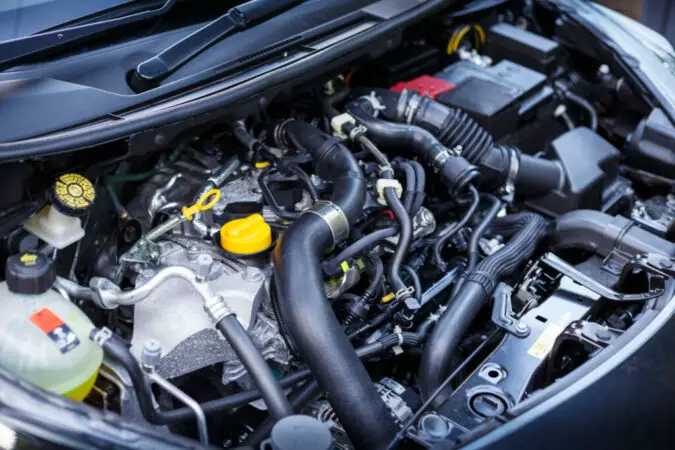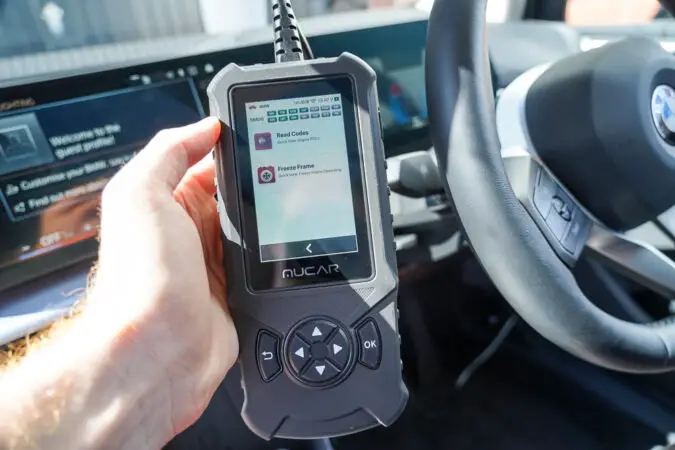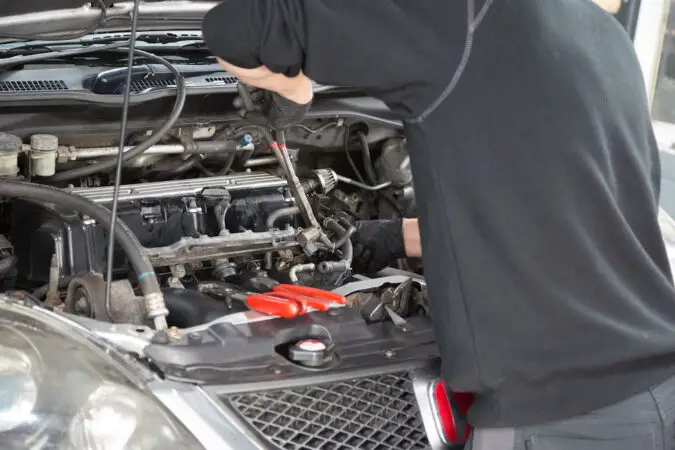Diagnostics trouble codes are generated when there is a problem with the vehicle’s sensors. Car manufacturers install dozens of sensors in every modern vehicle. So, these sensors are used to keep the car on the road and indicate issues that might cause problems. Read our article to know thoroughly about the code P0332.
Code P0332 generally portrays a problem with the knock sensor 1 circuit low input (bank 2). It usually means that the knock sensor on the engine is not working correctly and needs a fix. The car might run even after the problem occurs. However, it is best to address it as soon as possible to avoid further damage to the engine. But it might cause you to spend more than fixing the problem early.
Now, in this article, we will look into:
- Code P0332
- Causes
- Knock Sensor Function
- Common Symptoms
- Diagnosis (DIY)
- Fix
- Cost
- Common Mistakes To Avoid
P0332 Knock Sensor 2 Circuit Low Input (Bank 2)
The DTC P0332 is one of the most common issues a car has during its lifetime. It’s defined as, “knock sensor 1 circuit has low input (bank 2)”.
While operating, a vehicle’s engine puts a toll on the machine. When the air-fuel mixture in the car is not correct or a spark goes off early, it causes problems. The immense pressure in the engine can combust out of tune. Thus, it results in a knocking sound.
The knock sensor is responsible for monitoring the engine knocking sound. It constantly informs the computer of the car or the PCM if there is any abnormal knocking. The sensor holds the key to a safe driving experience. But is a replacement knock sensor still getting code P0332?
P0332 Code Causes
A faulty knock sensor may trigger several codes. A defective knock sensor causes a Diagnostic Trouble Code from P0325 to P0332. In this case, it fails to communicate with the Powertrain Control Module (PCM). But it is not the only reason the knock sensor code P0332 might be displayed.
Sometimes there might be problems with electrical circuits with the knock, or the connection might be faulty. The EGR system might be defective, or the air-to-fuel ratio is off-balanced.
However, the most common problem is a faulty knock sensor, connection, or poor wiring around it.
The knock sensor is under the intake manifold. Due to the location, it takes a long time to repair. So, scanning and rescanning the system before pulling your engine apart is a good idea. It helps to be sure of the problem.
How Do Knock Sensors Work
When we start our car, air and fuel are inside your engine. When the spark plug ignites the energy, there is an explosion. That is how the engine runs smoothly.
If the spark plug ignites the fuel quickly, the fuel and air mixture is not optimum there will be pressure. Sometimes the fuel is unsuitable for the engine, which also causes stress inside the machine. And the pressure causes another explosion inside the motor and causes a knocking sound. The purpose of the knock sensor is to detect the knock.
The knock sensor sends signals to the car’s computer when there is an irregularity in the system. So, the irregular combustion in the car engine may result in an explosion outside the combustion chamber. It might damage the engine, which may require costly repairs.
Typically, two knock sensors inside a vehicle with a 4-cylinder engine are separated into two banks. For 6-cylinder engines, there are between 2 to 4 knock sensors. For V8 engines, there are at least four knock sensors inside. So, the number of the knock sensor depends on how complicated the engine is.
A bad knock sensor sound is typically like thumping on the engine, gradually increasing. In the DTC P0332 code, it basically means a faulty knock sensor. If the code flashes in the scan tool, there is no easy way to fix the knock sensor. So, if you hear any abnormal sound, it is time to replace it.
Is Code P0332 Serious
The knock sensor is an integral part of the engine system. It detects an abnormal sound from the engine’s combustion and lets the car system know any abnormalities. It helps the driver see a couple of things. The spark plug is acting up early before adequate pressure is built, or the fuel is unsuitable for the engine.
Although many serious DTCs are out there that might be catastrophic for the car, P0332 is not one of them. In most cases, the P0332 acts up not because of an engine knock. Instead, it flashes because the knock sensor is offline.
So, if your check engine light is on and your scanner shows P0332, you don’t need to worry much. In the most severe cases, engine emissions will increase. But the worst case? The knock sensor won’t detect engine knock if the knock occurs when it is offline.
When you fail to cater to the problem for a prolonged period, it will be costly to repair the engine. The chances are very high that the damages will be extensive. Simple as it sounds, it has the potential to cause further trouble for the engine.
Bad Knock Sensor Symptoms
Usually, the code P0332 does not hamper the drivability of a car. It may result in a hot engine or engine emission. We recommend seeing a mechanic for a proper diagnosis to reduce engine damage if you face any bad knock sensor symptoms.
1. Poor Engine Performance
A bad knock sensor will typically cause a deficient engine performance. It means that the car will have trouble maintaining optimum performance. When there is a faulty knock sensor, the vehicle automatically reduces the performance of the engine by altering the timing.
2. Check Engine Light Is On
There is numerous DTC that will trigger the check engine light. However, knock sensor failure is the second most common car problem a mechanic sees daily. The only sure way to confirm the problem is to inspect the car using a scanning tool. If the code P0332 or P0327 pops up, it’s a problem with the knock sensor.
3. Bad Engine Timing
The most exciting automatic feature of the lousy knock sensor is that the car will slow down its timing. It will at least let you drive to the nearest garage. But it will not shut down the car’s acceleration, otherwise affecting the timing.
The automatic feature is there to avoid further damage to the car during the failure of the knock sensor.
4. Slow Acceleration
A car with a lousy knock sensor will make a thumping noise during acceleration. The vehicle will accelerate, yet, it will only move at a steady speed, not reaching the optimum speed. You’ll know the knock sensor is terrible when you feel a strange jerk and the car doesn’t move smoothly.
P0332 Code Diagnosis
The easiest way to determine the problem is through a scan tool to scan the whole system to find DTC. If you have a scanning tool and a decent idea about automotive troubleshooting, you are good to go. Use OBD II to scan the car. If the code P0332 or P0327 pops up, then be sure that the knock sensor needs to be replaced.
In almost all cases, the knock sensor replacement is necessary. As the sensor is an integral part of the car engine, you must do so along with the wiring.
Knock sensor replacement requires removing the engine intake manifold. It is a labor-intensive job that takes hours. Hence, it is suitable for a certified mechanic to do the job.
Is It Safe To Drive With Code P0332
Technically a car with a faulty knock sensor will work. However, the car will burn a lot more gas than usual. Afterward, it is very tough to say that the vehicle is safe to drive. The drivability depends on how much the engine relies on the knock sensor.
The possibility of running into an engine failure is evident. It is just a matter of time. To answer the question, it is not safe for the engine. So, be aware of the code P0332 and act swiftly to replace it.
How To Fix Code P0332
Knock sensors themselves are hard to fix. It needs replacement. The sensor is located under the engine’s intake manifold, challenging the substitute for many people. So, if your car is suffering from a faulty knock sensor, then you can follow the steps below:
Step 1
Diagnosis of the problem is the first step. If you’ve got a scanner and know how to use them, you are closer to fixing the problem. So, check to see that the diagnostic trouble code P0332 is popping up again. Thus, you’ll know the knock sensor is faulty.
But remember to scan the system twice to see if the problem persists. Due to the nature of the repair, it is a good idea to be sure about the issue. After that, take the necessary steps to fix it.
Step 2
After being sure about the error code, removing the engine intake manifold is time. Disconnect the fuel line and EVAP. Then use quick disconnect to disconnect the wires easily. Make sure you have all the tools at your disposal to do it yourself.
If a DTC P0332 pops up and you want to know how to replace it, you can watch this video.
Step 3
Remove the knock sensors and check to see if the wiring is OK or not. It is a simple fix but requires heavy labor to do so. Thus, it is good to be sure to replace the wiring and the knock sensor. After replacing the sensor, clear the code and rescan it to see if the code pops up again.
Knock Sensor Repair Cost
It is hard to crunch up a number for the cost of knock sensor replacement. The vehicle, problem, and the mechanic’s hourly fee vary from one place to another. After visiting a garage, the mechanic will take time to diagnose the problem and ensure the fix. But that doesn’t mean you’ll have to burn a hole in your pocket just to fix it.
The diagnosis time is an hourly charge in most cases. And the rough estimation is about $75 to $150 per hour. Depending on the problem’s nature, it might take an hour to diagnose or upwards of 2 to 3 hours.
A knock sensor costs $10 to $100, and the replacement cost ranges from $180 to $300.
So, the whole process will roughly cost about $500 to $700, depending on the mechanic. The cost is not definite and will fluctuate from place to place. Thus, get the proper support from a trusted source for a better fix.
Suppose you are someone who replaced the knock sensor and are still getting code P0332. We recommend going to the mechanic to fix the problem. A professional can be very helpful in these cases.
Although you might be interested in doing the fix yourself, we stand by our recommendation of getting professional help.
Common Mistakes To Avoid While Fixing Code P0332
The most common mistake in all cases is a rushed diagnosis. If you fail to diagnose the problem correctly, it will be very costly for your pocket. Sometimes an improper diagnosis will cost you thousands of dollars of replacement parts and labor.
The second most common mistake regarding fixing the error code P0332 is, replacing only one knock sensor. You should change the knock sensors and the wiring. So, to avoid an increased chance of damaging the second knock sensor in the replacement process.
Sometimes the problem moves to the old wiring from the lousy knock sensor. If you only change the knock sensor, then there is a fair chance that the problem will resurface again. It will force you to go through the process for the second time.
Thus, we recommend caution while changing the knock sensor of your vehicle. It is tempting to do the repair and scanning yourself, but we suggest seeking professional help. The fix might not be as challenging for most enthusiasts as beginners. However, we strongly urge everyone to have professional support to avoid mistakes.
How To Fix The Knock Sensor Code
Knock sensors are usually replaced rather than fixing the sensor. The sensor is cheap, but the labor time and cost are heavy. Because the sensor is positioned beneath the engine’s intake manifold, many people find it difficult to replace it. If your car has a defective knock sensor and you want to fix it yourself, then follow these steps:
Step 1
The first step is to diagnose the problem. If you have scanning tools and the know-how to utilize them, you’re closer to resolving the issue. If the diagnostic trouble code P0332 appears after scanning, you know you’re dealing with a malfunctioning knock sensor.
Step 2
Once the trouble code is confirmed, remove the engine intake manifold. After that, disconnect the fuel and EVAP lines.
Step 3
Remove the knock sensors and inspect the wiring to verify it is in good working order. It’s an easy repair, but it’ll require much effort. To be safe, replacing the wiring and the knock sensor is a good idea. Make sure to clear the code and rescan it after replacing the sensor to check whether the code appears again.
If you’ve replaced the knock sensor but still see code P0332 in the scan tool, we recommend visiting a mechanic. In these situations, professionals can be beneficial. They will be able to resolve the issue.
Although you may be tempted to repair yourself, we strongly recommend hiring a professional.
P0332 Code: Need-to-Know Facts
- The P0332 code is a diagnostic trouble code that is stored when the knock sensor 2 circuit gives a low input signal to the PCM.
- The knock sensor’s purpose is to signal to the PCM when the engine is pinging. If the PCM is receiving a reading from the knock sensor that is too low, it will not be able to accurately send the appropriate signal of a ping.
- Common causes of the P0332 code include a faulty knock sensor, a fault in the knock sensor circuit or its connectors, an air/fuel ratio that’s too lean, a problem with the cooling system, and a defective EGR system.
- Symptoms of the P0332 code may include pinging in the engine when accelerating, increased engine heat under normal operation, and lack or loss of power.
- To diagnose the P0332 code, a mechanic will likely begin with a visual inspection of the sensor and its circuit, then use an ohmmeter and other diagnostic tools to test the circuit, connectors, and other related components.
- Common mistakes when diagnosing the P0332 code include a failure to properly inspect and diagnose the root of the problem.
- The P0332 code is serious because engine pinging can take a toll on an engine’s ability to run cleanly and efficiently.
- Repairs that can fix the P0332 code include replacing frayed or broken wires and connectors in the sensor circuit, ensuring that the sensor and circuit are properly grounded, replacing the knock sensor, addressing the root cause in the EGR or cooling system, and replacing or reprogramming the PCM (rare).
- Even if you notice no other issues or symptoms with your vehicle, the P0332 code will result in an illuminated Check Engine light. If this light is on when you go in for an OBD-II emissions test, your vehicle will not pass.
- Getting the P0332 issue resolved early can avoid a lot of headaches, as well as more involved and expensive repairs down the road.
Conclusion
If an issue with a car’s engine is not addressed quickly, it might be dangerous. In most circumstances, the cost of repair will rise over time as you continue to drive with engine issues.
So, we constantly advise fixing the problem as quickly as possible to prevent unnecessary strain on the engine. Be smart and be active in fixing troubles like P0332. You never know how the issues might multiply.
At last, we arrived at the end. So, thank you so much for reading till the end! Hopefully, we were able to impart the knowledge correctly for you to understand. Until then, take care and maintain your car properly!
FAQs
Here are some popular FAQs:
What Causes A Knock Sensor Code
A faulty knock sensor usually causes diagnostic trouble from P0325 to P0332. It happens when the sensor fails to communicate with the Powertrain Control Module. Sometimes there are problems with electrical circuits with the knock, or the connection might be defective. In rare cases, the EGR system becomes defective, or the air-to-fuel ratio is off-balanced. Yet, our research found that the most common problem is a faulty knock sensor, faulty connection, or poor wiring. The knock sensor is located under the intake manifold, which requires removing it to reach the sensor. It is good to use the scan tool to scan the problem. It helps to ensure the issue before going through the labor-intensive repair process.
What Does Code P0332 Mean
A defective knock sensor might set off a variety of codes. A faulty knock sensor that fails to connect with the Powertrain Control Module causes Diagnostic Trouble Codes P0325 through P0332. The knock sensor code P0332 might appear for a variety of reasons. Electrical circuits may have problems with the knock, or the connection may sometimes be faulty. It’s possible that the EGR system is malfunctioning or the air-to-fuel ratio is unbalanced. However, the most common issue is a malfunctioning knock sensor, poor connection, or improper wiring. Because the knock sensor is under the intake manifold, it is a complex and time-consuming repair. So, before you start dismantling your engine, it’s good to do some research. Otherwise, all your efforts will be for nothing!
What Is Code P0332
The knock sensor is an essential component of the engine. And it detects an abnormal sound from engine combustion and alerts the vehicle’s computer system. So, it informs the driver on a few points. The spark plug is sparking early before enough pressure builds up or the fuel is unsuitable for the engine. Although several critical DTCs could be fatal to the vehicle, P0332 is not one of them. The P0332 signal flashes because the knock sensor is offline in most circumstances. In these cases, it is doubtful that there is a knock. So, carefully inspect your vehicle.
Can You Drive With A Faulty Knock Sensor
A car with a malfunctioning knock sensor can be technically drivable. However, the vehicle will consume significantly more gas than usual. It’s difficult to say how safe the car is. The drivability depends on how much the engine relies on the knock sensor. There’s a good chance you’ll have an engine failure. It’s simply a matter of time. The simple answer is that the engine is not entirely safe. As a result, be aware of the P0332 code and act quickly to replace it. Otherwise, you might face long-term problems.
Is It Expensive To Replace A Knock Sensor
The cost of knock sensor replacement is difficult to calculate. The hourly fee of a mechanic varies depending on the vehicle, problem, and location. Typically, the mechanic will diagnose the situation after visiting a garage to be confident about the fix. In most circumstances, the diagnosis time is billed hourly. The hourly rate is between $75 to $150. Depending on the nature of the problem, the diagnosis could take an hour or two hours. A knock sensor can cost between $10 and $100, with replacement costs ranging from $180 to $300. Depending on the mechanic, the entire procedure will cost between $500 and $700. The price is not set in stone and will vary depending on where you go. So, be sure to remember the prices along with their distances!




